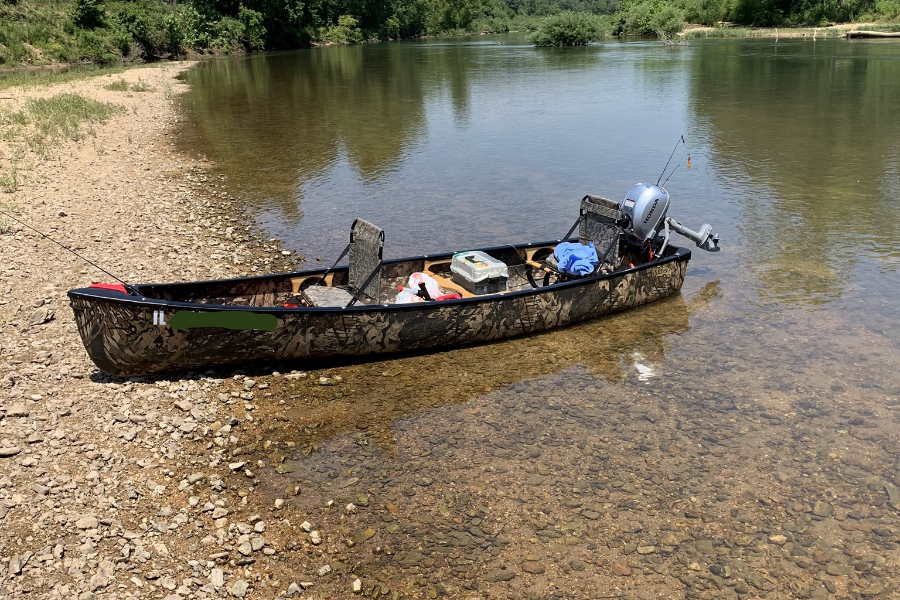Mounting a Trolling Motor to a Canoe

If you are looking for a way to add some power and speed to your canoe, consider mounting a trolling motorto a canoe. This can be a great way to get around on the water with ease.
So, whether you are an experienced canoer or just getting started, read on for information on how to add a trolling motor to your setup!
In this blog post, we will explain how to mount a trolling motor. We will cover the necessary materials and steps required for mounting a trolling motor to a canoe.
What Is a Trolling Motor?
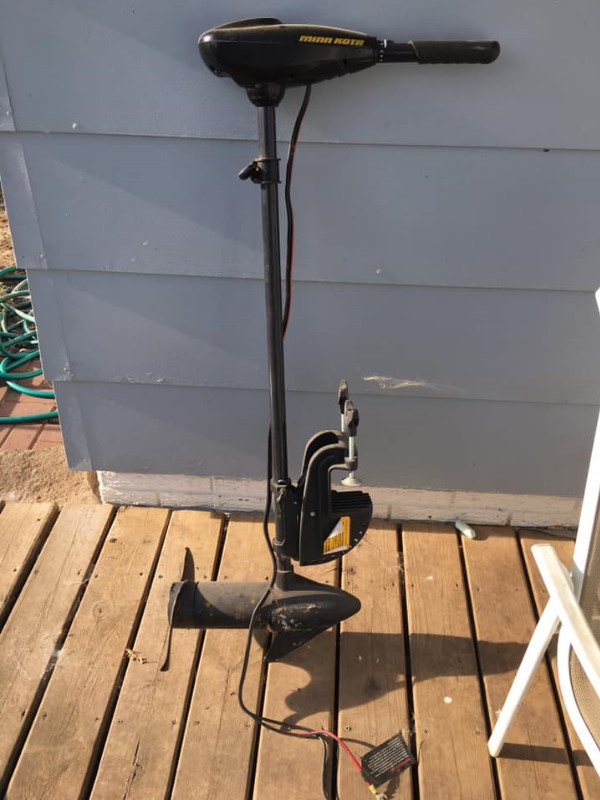
A trolling motor is an electric motor that is designed to be used for slow-speed boat propulsion. It is typically mounted on the stern (back) of a boat and controlled with either a foot pedal or hand-held remote control. The speed of the motor can be adjusted, giving you greater control over your canoe’s direction and speed.
Trolling motors are the perfect companion for a day of fishing on your canoe.
These small electric motors provide enough power to guide you through water without making too much noise that might scare away potential catches and come in four voltage options 12V, 12/24V, 24V, and 36V. The higher the voltage level translates into greater engine performance; so while a conventional outboard motor is measured by horsepower (HP), trolling motor output strength is determined in pounds of thrust – 40 lbs from a standard12-volt model up to an impressive 100lbs produced with its counterpart at maximum capacity!
Additionally, buyers looking for an optimal solution have access to both battery and gasoline-powered motors depending on what best suits their vessel’s specific requirements.
A trolling motor features three distinct components which work together to power your journey – the motor, propeller, and controls.
The engine sits in a waterproof compartment at the end of the shaft which shields it from the water’s depths and prevents overheating during operation!
A standard propeller lies at the bottom of a shaft of the motor and consists of either two long blades or three-to-four short ones that generate thrust through water movement when activated by the control system.
3 control systems: hand, foot, or wireless operated. Whichever option works best for each adventurer can be decided upon examination of their respective pros and cons.
Hand controls offer the least expensive option with ease of use but require a one-handed operation.
Foot control motors provide both hands-free while steering but can be challenging to coordinate speed, plus they need a special bracket for attachment.
Wireless motors offer all advantages in terms ranging from learnability, freedom of movement, and cost – however, they remain more difficult (and costly) than other models previously mentioned.
Ultimately it’s up to each user on what works best!
How does a trolling motor work?
Trolling motors are powered by electricity, usually from a 12-volt battery that is mounted on the stern of the boat. When the motor is activated, it will rotate a propeller in one direction or another depending upon the direction chosen by the user with either a foot pedal or hand-held remote control.
The power generated from the spinning propeller will then push against the water and propel your canoe forward. To move in reverse, you can simply switch directions and pull back on the throttle for slower speeds.
Advantages of Mounting a Trolling Motor on a Canoe for Fishing
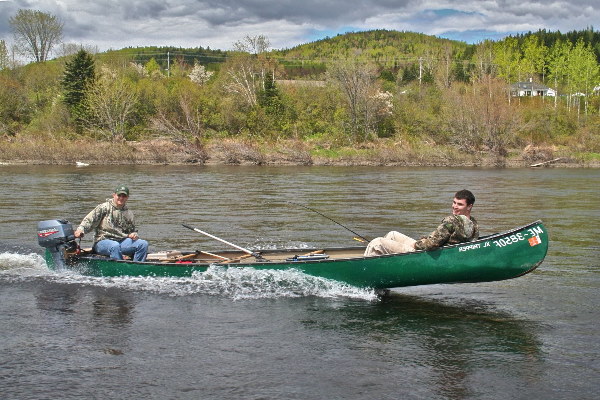
Mounting a trolling motor to a canoe setup can provide many advantages, such as increased speed and range on the water.
Mounting a trolling motor on a canoe can make it much easier to navigate through your favorite fishing spot or get around tricky obstacles. By using the trolling motor, you’ll be able to keep your hands free while steering, so that you can focus more on fishing than maneuvering the boat.
Trolling motors are also much quieter than conventional outboard motors, which allows for a quieter trip that won’t scare away potential catches.
Plus, with its electric power source, there is no need for gas!
Another great advantage of having a trolling motor is that you have greater control over your boat. This allows you to maneuver in tight areas or make small adjustments without expending too much energy paddling.
Another benefit is that if unfortunately, you lose your paddle while fishing, a trolling motor is a great lifesaver.
Finally, trolling motors can help reduce fatigue while paddling by providing an additional source of propulsion when needed. You also have more time to fish instead of traveling.
Things to Consider Before Mounting a Trolling Motor to a Canoe
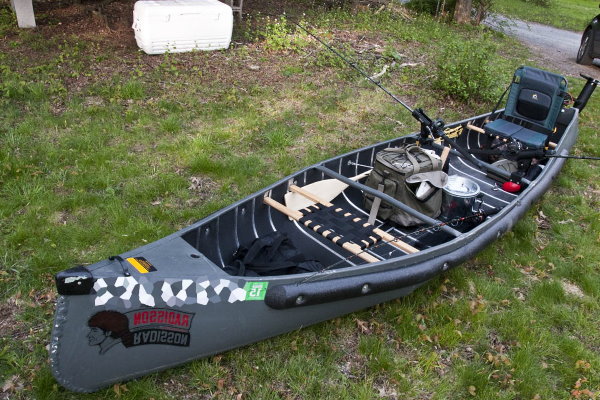
Before purchasing or mounting a trolling motor to a canoe, it is important to consider several factors such as:
The size of your canoe
You will need a trolling motor that is the correct size for your canoe. If you have a larger canoe, then you may need a larger motor with more power and thrust.
The type of water you are navigating
When it comes to freshwater and saltwater, utilizing the incorrect type of motor can have severe consequences. Only motors specifically designed for marine environments are best suited to avoiding corrosion – stainless steel components along with sealed electric parts protect their internal systems from rusting away over time.
Unfortunately, if you do happen to utilize a regular freshwater motor instead that wasn’t made for sea-faring conditions, then not only will your warranty become void but chances are high that said engine could corrode rapidly up to points past repairability altogether.
On the other hand, using a saltwater motor in freshwater is fine – just be sure not to get them mixed up when setting out on your voyage!
Operating a freshwater motor in saltwater can be tough on the device, but with quick action, it doesn’t have to mean total disaster! Take time for an immediate rinse of your engine after each use and you can avoid corrosive issues from occurring.
The Motor
Weight of the motor:
It’s also important to factor in the weight of the motor when determining which size will work best – too much weight can throw off the balance of your canoe!
Shaft or Tube Length:
The motor should have a shaft long enough to allow for full submersion in the water. To maximize effectiveness, it is ideal that this submergence extends one foot below the surface of the water.
Mounting Location
Outfitting your canoe with a motor gives you the power to explore further and faster. Whether it’s added agility in rapids or increased distance along flatwater, attaching an engine comes down to deciding where best suits its placement on your vessel – bow, stern, or the transom! With two motors, however; one at the transom (stern) of the boat paired with another upfront offers unparalleled control while cruising open waters.
These are just a few things to consider before selecting the best trolling motor for your canoe setup. With the right preparation, you will be able to enjoy smooth sailing on your next fishing adventure!
Materials Needed for Mounting the Trolling Motor
Before you begin mounting a trolling motor to a canoe, make sure to gather all of the necessary materials:
A Canoe
If you don’t already have one, consider buying a canoe that is the right size and weight for your trolling motor.
The canoe needs to have adequate space for the motor as well as mounting hardware.
A Trolling Motor
Electric trolling motor
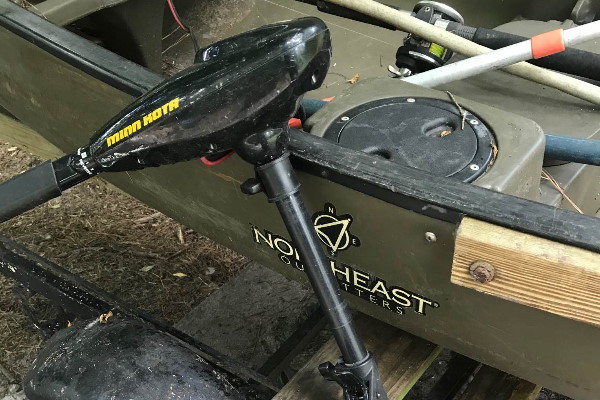
Electric trolling motors are quickly becoming the superior choice of propulsion for canoe owners.
They boast a powerful battery-operated power source and carry one key advantage over their gas counterparts – lightweight portability without accompanying fumes! With no need to haul a heavy tank full of gasoline, electric motors provide more freedom without sacrificing performance.
Not only do they boast a simple installation process with just one clamp, but most also come loaded with modern features such as GPS navigation and autopilot systems, route tracking capabilities, and battery gauges that help you take complete control of where you are going.
Don’t worry about replacing this powerhouse anytime soon – good quality motors will keep powering up your boat for years to come.
Voltage, power, and thrust:
When looking for a motor to power your canoe, you have the option of 12v, 24v, and 36v. The choice between them is largely determined by how much thrust you need to efficiently move through water – accounting for factors such as wind direction and strength, current speed, and the weight of your boat. Generally speaking,12 volts will max out at 55 pounds of thrust; 24 up 80 lbs; while with 36 improved performance can be expected that takes it all way up 105 lbs! But 24 volts and 36 volts require additional batteries.
Knowing this information before purchase may prove essential in finding an optimal balance between voltage levels versus brute force needed when navigating different types of waterways.
You’ll also want to make sure that your battery is powerful enough to sustain long days out on the water. The last thing you want is to have a dead battery mid-trip.
Gas-powered trolling motors
For those looking to travel at speed and with more power, a gas-powered trolling motor may be the ideal choice for their canoe.

While they provide faster speeds and more oomph than electric motors, their drawbacks can be hard to ignore: added weight due to a bulky build plus an accompanying gasoline tank; loud noise levels in operation; messy fuel spills during use or maintenance routines; and extra upkeep requirements that come with a higher risk of costly repairs or replacement down the line. Weighing one’s needs against these considerations is key before investing.
With a gas-powered motor, you can take to the water with unrelenting force. Though electric motors may lack power, their lightweight design and low maintenance requirements make them an attractive option for those who prefer not to carry extra fuel or concern themselves with upkeep. Whether powerful or portable—the choice is yours!
Horsepower
When it comes to getting the most out of your canoe, you’ll want to pay attention not only to thrusting power but also weight. A gas-powered trolling motor with a horsepower rating tailored for your craft’s load can be just what you need.
When picking an engine, there are many factors at play: wind and current must all be considered as they can easily adjust how much push that little engine provides in either direction.
But beware; too much HP could send your boat careening off course into hidden banks or rocks – 2 horsepower is usually enough.
Journeyers who understand the importance of balancing between adventure and safety alike will know that any good voyage starts by striking this perfect balance before ever setting foot on land or water!
Canoe Mounts
Top rail trolling motor mount
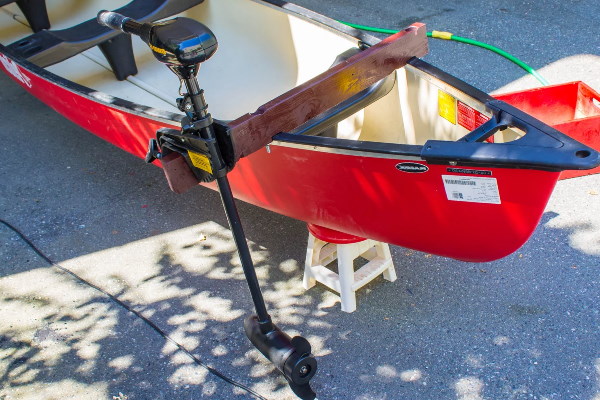
Looking for the optimal way to attach a trolling motor to your canoe? Look no further than top rail mounts! With this type of mount, you’ll get all the convenience and stability – plus it can be attached easily on just about any kind of wood or aluminum-sided canoe.
Using two blots and a retainer/clamp system to ensure secure attachment of the flat bar with an extend out on one side on the top rails of your canoe.
To this flat bar is then bolted an upright block made from hardwood like Ashe which will form a unique base sturdy and reliable.
The disadvantage of this mount is limited weight capacity or thrust power.
Side saddle trolling motor mount

A side saddle mount is the ultimate option for keeping your trolling motor secure to a canoe. Shaped in the form of a triangle, these mounts clamp onto and wrap around the top rail of your boat. The top of the mount is attached to a block, where to mount the trolling motor.
This type of mount is usually made by canoe manufacturers so it can fit your canoe perfectly and connect securely.
Outfitting your canoe with a side saddle mount offers many advantages. Not only is it the ideal fit, but its strength and durability make sure that no matter how powerful of an engine you decide to attach, you won’t have any concerns when taking on the water!
What’s more, this unique mounting option ensures access remains unhindered across all areas of the boat. Enjoy increased safety and performance without sacrificing convenience – it’s what owning a motorized canoe should be about!
Tool
Screws/Bolts:
These are used to attach the mounting brackets to the frame of the canoe. Make sure they are appropriate for the type of material your frame is made from (aluminum, wood, etc.)
Wrenches or Hex Keys :
This will come in handy when tightening the nuts on your screws and bolts to ensure a secure mount.
Drill:
A drill is necessary for drilling holes in the canoe frame as well as for driving screws and bolts, depending on the type of mount you use. If mounting with a side saddle mount, a drill will be necessary for pre-drilling holes around the paddle rail before attaching.
Hacksaw:
This tool can be used to cut metal pieces when needed. Be sure to wear protective goggles when operating a hacksaw!
Level:
When installing the motor mount, it must be level so your motor runs smoothly with no excessive vibrations. A level is an essential tool in this process.
Safety Gear:
When working with any type of machinery, safety gear such as gloves, goggles and a face mask are essential. Always be cautious when working with tools and take the necessary precautions to ensure your safety.
Finally, if you’re not much of a DIYer or simply don’t have the time to install the mount yourself, consider hiring a professional outfitter who can do it for you. This way you can rest assured that your motor will be mounted correctly and securely – leaving only the fun part of paddling! Good luck on your upcoming journey!
Instructions for Mounting a Trolling Motor to a Canoe
When mounting a trolling motor to a canoe, there are several steps you must take to ensure that it is secure and ready to use safely.
1. Begin by choosing the proper mount and motor for your canoe.
2. Purchasing the necessary parts and tools for the job, including mounting brackets, screws/bolts, and any other tools required.
3. Decide where to place the mount and motor (stern, engine, or bow)
4. Attach the mounting brackets to the frame of your canoe using screws or bolts. Make sure that they are securely fixed in place before continuing with the next step.
5. Pre-drill holes around the top rails of your canoe if you’re mounting a side saddle mount – this will make it easier to attach later on.
6. Once all parts have been attached, use an appropriate wrench or hex key to tighten all nuts and bolts so that everything is secure and stable.
7. Take time to check that everything is level once more before attaching the motor itself – this will ensure vibrations don’t occur during use.
8. Carefully attach the trolling motor to the block at the top of the mount, following all manufacturer’s instructions for safety reasons.
9. Once everything is attached, check that all nuts and bolts are tight and secure before testing out your new setup!
10. Test it out in the water.
With these steps followed correctly, you’re good to go – time to take your canoe onto the water and enjoy a peaceful day fishing or just exploring! Your trolling motor will be safe and secure as you venture forth – happy paddling!
Mounting a Bow Motor
Serious fishermen choose bow mounts to get the most out of their time on the water. By pulling the boat through the water, rather than pushing your boat like a transom motor would, you can easily control and direct where you want to go – perfect for those who know what they’re doing!
Begin by measuring the mount’s desired location on your deck. Its screws must pass through only the deck and not the hull of your vessel.
Use the mount base to plan out where exactly these holes should be. Anyway, you don’t want to find out that your holes aren’t in the right places after drilling.
Then grab a drill and make ¼” deep impressions in those exact locations – clearing away any sawdust afterward is also essential for good measure!
Lastly, place each bolt through its designated hole accompanied by washers as added cushioning under that mounting base for added grip and stability
Positioning the mount base into the holes that you prepared – ensure it is level with the deck. Use a level to determine if you need to re-drill any holes.
Once everything looks shipshape, attach a washer onto each bolt and fasten down the motor as per manufacturer instructions.
Finally, make sure all pieces are firmly held in place for safety’s sake: from secure mounts connecting your boat and motor, down to screws being extra tight.
Make sure to find the perfect depth for your trolling motor – not too high, but also not so low that operating gets uncomfortable. Strike this balance by ensuring that the bottom of the last propeller blade is 5 inches underwater or 12 if standing while running.
Mounting an Engine Motor
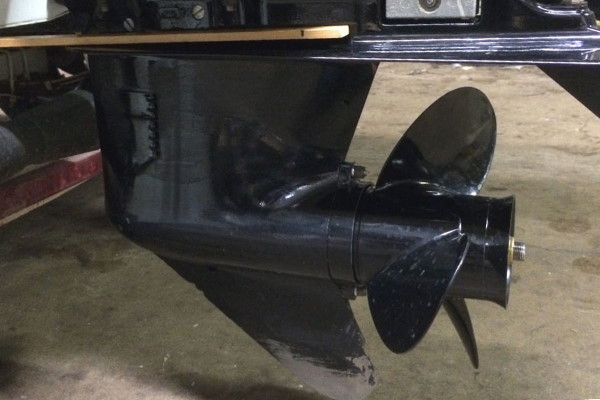
Outboard engines are equipped with engine-mounted motors by an anti-cavitation plate, an innovative solution that allows them to provide thrust while saving valuable space on deck. By raising and lowering the motor underwater as necessary, these multi-purpose boats can benefit from increased efficiency at high speeds – although maneuverability is sacrificed for functionality in this instance.
To secure the engine motor and ensure it runs smoothly, places its mounting bracket on top of the anti-cavitation plate.
To mark out where to drill your bolts into this horizontal surface above the propeller, use the mount as a template.
With utmost care for accuracy, grab that sharp drill bit—it’ll be essential in piercing through metal—and get drilling!
Subsequently, rest the bracket over these marks and firmly install bolts into place – double checking for stability before heading onto open waters with confidence.
The anti-cavitation plate should remain at least 13 inches deep when submerged so that once operationalized your motor will run 6 inches below sea level. Safety first!
Mounting A Transom (Stern) Motor
Smaller boats can benefit from a transom motor, as it is easy to mount and doesn’t take up much space. It’s an economical option compared to its bow-mounted counterparts – ideal for those looking to enjoy the freedom of canoeing without breaking the bank!
However, bear in mind that control may be less precise than with other motors due to the limited options available.
Mounting a trolling motor to a canoe is simple! Just ensure that you’ve got the right clamps and plenty of space to get the job done. Most manufacturers provide clamps specifically designed for transom-mounted motors.
To attach, simply turn the clamps counterclockwise to open and slide onto the stern of your boat as close to the center of the stern as possible; then tighten by turning clockwise as far as possible for secure installation onto your vessel. Simple yet effective!
Need to free-mount your trolling motor but don’t have a clamp? Need to mount one on the transom, or not perfectly centered at the stern? No problem!
You can easily create a custom solution for your canoe when you use 2x4s and some creative carpentry. To achieve this, start by measuring and building a piece that runs across the back of your canoe for it to stick out approximately 6 inches on the side of the boat where you’d like your motor placed.
Then find a suitable mounting plate that fits perfectly with your trolling motor. Securely attach it to the flat piece behind your seat with screws and washers, and test that you can access your motor easily when out on the water.
FQAs
Is it Legal when mounting a Trolling Motor on a Canoe?
Yes, it is legal to mount a trolling motor.
However, after mounting a trolling motor to a canoe, it’s imperative to acquire both registration and a title for your canoe – don’t forget to bring them on each water-bound excursion! You may also need to put numbers conforming to state laws onto the kayak. Do a quick double-check of local regulations before hitting the waves; safety is key out there!
Do I Need A License To Operate A Trolling Motor?
No, you do not need a license to operate a trolling motor. However, depending on where you are operating the motor, you may need to register it for use. Check with your local authorities for more information.
How do you register a canoe with a trolling motor?
Whether powering along with diesel, gasoline, or an electric motor such as a trolling motor, if you’re planning to take your boat out for fun on the water then don’t forget that it needs to be registered!
The process of registering a canoe with a trolling motor typically depends on the state in which you are operating. Generally speaking, you will need to have your canoe inspected and meet certain requirements before registration is granted.
In many states, to get started simply head down and visit either your Department of Motor Vehicles or Licensing.
Be sure to check with your local authorities for more information.
Once this is done there’ll be nothing standing in between you and hitting those waves – just remember to affix that shiny new license plate securely on board!
How Fast Will a Canoe Go With a Trolling Motor?
Mounting a trolling motor to a canoe can propel it at speeds from 3 to 6 mph.
When you’re out on the water, trolling motors offer a slow and steady approach that is perfect for their purpose: fishing.
Offering speeds no faster than 5 miles per hour regardless of motor size or type of boat, these devices are designed to keep your vessel moving along at just the right pace without risking damage due to too much power.
But if speedier travel is what you desire, be sure to source another kind of motor before heading out onto the waves!
How long will a 12v battery run a trolling motor?
The amount of time a 12-volt battery can run a trolling motor depends on the size and configuration of your boat, as well as how much power the motor is drawing.
Generally speaking, you can expect to get around 8 hours of continuous use out of a fully charged 12-volt battery when powering an average-sized trolling motor.
So if you’re planning on some serious fishing expeditions then make sure to bring along extra batteries or opt for higher-capacity ones before heading out onto the water!
But keep in mind that this figure may vary based on conditions such as weather and current speed – always test beforehand to be certain.
Is it OK to use a car battery for a trolling motor?
No, it is not recommended to use a car battery for a trolling motor. The voltage from the car battery can be too high and may damage the trolling motor. Additionally, the lifespan of a car battery used for a trolling motor will be significantly shorter than one dedicated to this purpose.
It is best to invest in a deep-cycle marine battery specifically designed for your trolling motor. These specialized batteries provide reliable power out on the water while also giving longer life spans so you don’t have to worry about constantly replacing them.
You’ll thank yourself later when you start feeling those peaceful vibes on your next fishing adventure!
Is 30 lb thrust enough for a canoe?
Yes, a 30 lb thrust trolling motor is typically enough to power a canoe. The amount of thrust needed depends on the size and weight of your boat, as well as the type of water you are operating in (e.g., still or choppy).
Generally speaking, a 30 lb thrust can move a canoe at speeds up to 5 mph for short distances in calm waters. However, if you plan on traveling long distances or in rougher waters then it may be best to opt for higher-thrust motors that provide greater power-to-weight ratios.
Regardless of which model you choose, always remember to have fun – safety first! Be sure to Remember: always check with local authorities for the regulations and laws surrounding motorized canoes in your area. And of course, never forget to wear a life jacket! With the right precautions and a bit of practice, you’ll enjoy power-boating in your canoe like a pro!
Conclusion
Mounting a trolling motor to a canoe can be a great way to make your fishing trips more successful. By considering the factors we’ve outlined in this post, you can make sure that your trolling motor is mounted safely and securely on your canoe.
If you have any questions about the process, please don’t hesitate to reach out to us. We’re always happy to help our fellow anglers achieve their fishing dreams!
Thanks for reading our article about Mounting a Trolling Motor to a Kayak. If you have any questions, leave a comment below. You can see more posts on our website here.
Further reading

